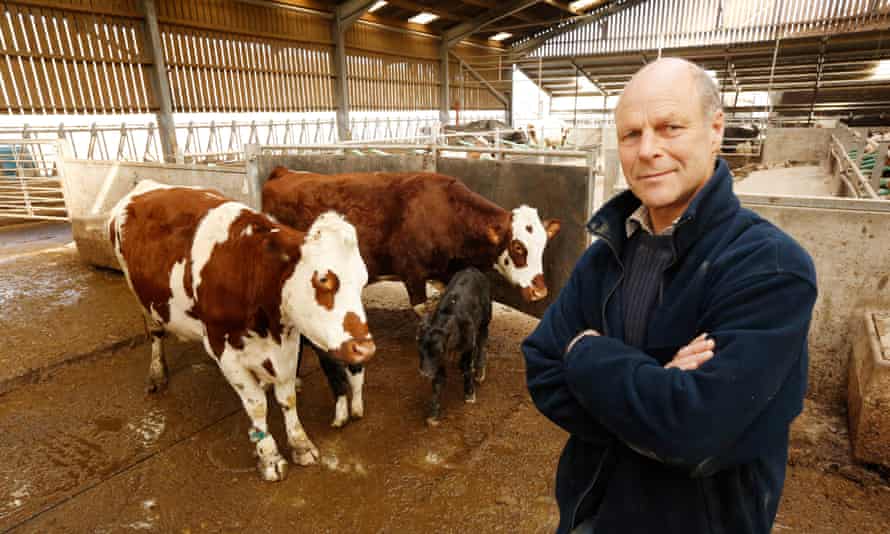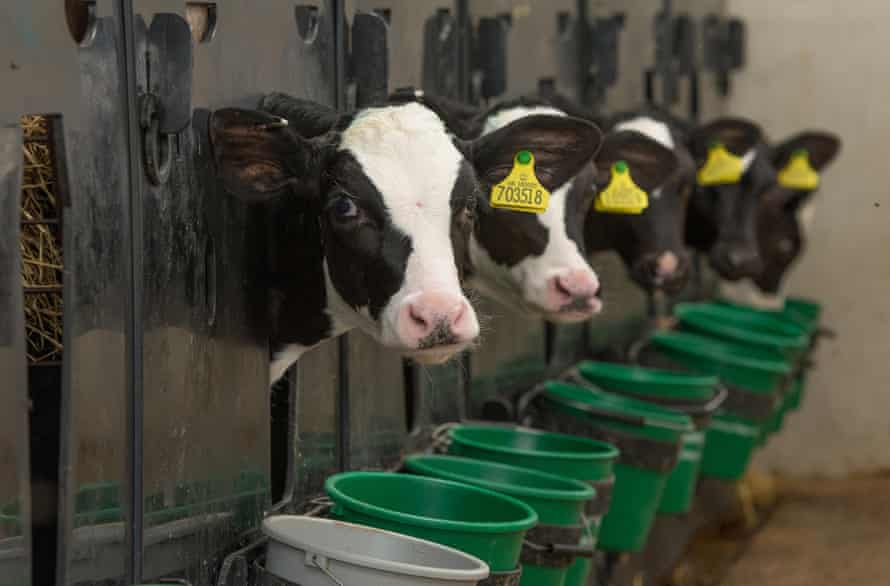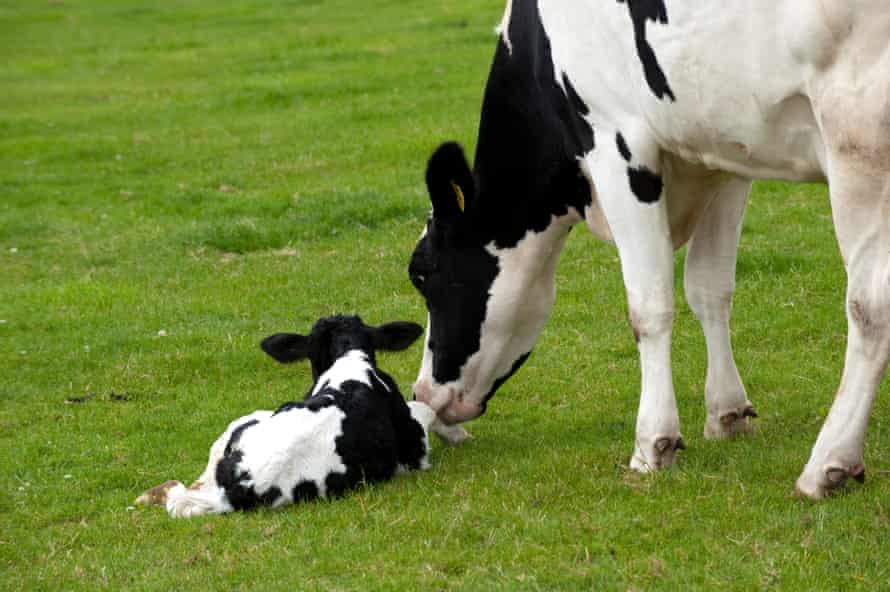Beef Calves Being Separated From Mothers
A field of cows with suckling calves may sound like a normal rural scene. In fact, the view at David Finlay'due south farm on the Dumfries and Galloway declension is a sight you'd be unlikely to see on any other dairy farm in the UK.
Almost all calves are separated from cows within hours or days of birth on dairy farms. This allows farmers to sell the milk that the calves would otherwise drinkable.
But it is a reality of dairy farming that jars with animal welfare campaigners and consumers, and one of the sector's three biggest emotive issues, along with giving cows outdoor access and the killing of male calves direct later nascency.
"It'south the one thing we've ever been asked well-nigh by mums on our farm tours," says Finlay. "They simply don't like seeing calves separated from their mothers so soon."
The public reaction has led to a tiresome growth of a new sector, calling itself "ethical dairy farming", where the calves are not removed immediately from their mothers. One adept estimates that effectually 400 dairy farms in Europe and Commonwealth of australia are trialling methods – varying widely from one farm to the adjacent – for what is known as "calf at foot" systems.
With a herd of 125 cows, Finlay's farm about Castle Douglas in due south-west Scotland is the largest known producer in Europe to introduce the calf at foot system. But the switch, at present in its third year, has been far from easy.
Finlay began the project in 2017 with the hope of proving such a method could work at a bigger scale. "The start year was disastrous," he says, admitting that he wanted to call it quits. "We merely couldn't get the cows away from the calves and into the milking parlour. For weeks we'd exist dragging the cows in there.

"It took a long time for them to trust that the calves were notwithstanding going to exist there when they came back. It was then much stress as the cows merely weren't used to it and didn't know what the rules were."
Finlay had to exist talked into keeping the system going for some other yr by his family unit and other staff subsequently his herdsman grew sceptical about the project and left, simply by the second twelvemonth the cows had begun to grow used to having their offspring around.
The calves still need to be separated after weaning at around 5 months, a procedure Finlay and his new herdsman Charles Ellett have learned to manage by starting off with overnight periods of separation first.
"That first day we don't open up the gates in the morn though at that place is a huge outcry from the calves and cows," says Finlay, who has got round it by introducing a surrogate mother – usually an older cow not producing much milk. They then use this cow to atomic number 82 all the calves into a field on the other side of the subcontract to settle them.
The initial period of overnight separation helps create social bonds between the calves, says Finlay, making the final separation easier. The female calves will so stay on the farm to become milking cows, while the male calves are sold after 5 to seven months to produce veal.
Leaving calves with their mothers has been found to reduce mortality rates and assistance them grow quicker by having all-twenty-four hours access to their female parent's milk, rather than a milk powder substitute. The suckling can also help protect cows against mastitis, one of the biggest disease risks facing dairy farming today.
Notwithstanding, the suckling adds up to "crazy amounts of milk" lost to the farmer to sell, says Finlay. He estimates his losses at more than 2,000 litres per cow being taken by the calf, which equates to upwards of £500 in lost revenue based on the current UK average milk cost. The cows also hold dorsum fat for their calves when taken into the milking parlour, "giving us semi-skimmed milk", jokes Finlay.

But Finlay believes the model can work and that the improvement in the health and allowed systems of the young calves will yield long-term dividends that volition compensate, to some extent, for loss of milk. And he has already seen a surge in interest in what he is doing from beyond the Great britain and overseas.
Last year he raised more £50,000 through a crowdfunding entrada to support the farm and its cheese production facilities. Conversely, vegan activism has besides helped, he says.
"There was no demand for it before, but vegan campaigners have raised awareness [among consumers of college brute welfare] and created a market place for united states to supply dairy to. Found-based milks have also got people used to paying more for dairy," he says.
It is the loss in milk more anything else that Finlay thinks will put off all simply a niche group of dairy farmers from ever considering it unless they can secure a premium for the leftover milk. However, he is hopeful that consumer support for more than ethical farming approaches will be boosted by activism.
But other dairy farmers remain sceptical of the health and welfare benefits for the cows and calves – besides every bit the economics of making information technology feasible. "Information technology'southward only ethical if you don't know what the downsides are," says National Farmers' Matrimony dairy board member Phil Latham, who runs a dairy farm in Cheshire and separates his calves at one week.
"Yes, the calves go to spend more time with their mother, but in that location are a whole host of compromises with an increment in disease risk from the mixing of different age groups and a lack of control over the dogie's food intake. The longer you leave the calf on the cow, the bigger the stress when you practice carve up them.
"It's pandering to urban ignorance. If he can get a market place premium from doing it and survive the milk losses then good luck to him, just information technology's not about maximising welfare in my listen," he says.

Bookish researchers say early separation within 24 hours has been plant in some cases to reduce distress for both beef and dairy cows and calves, although the bear witness for dairy calves is all the same inconclusive. "The faster you suspension the bond [between moo-cow and dogie] the fewer vocalisations you are going to get from calves," says Marina Von Keyserlingk, a professor in fauna welfare at the University of British Columbia.
Helen Browning, dairy farmer and CEO of the organic trade torso the Soil Clan, separates her calves and cows within 24 hours, but then keeps them with a surrogate mother moo-cow who has been retired or rested from the dairy herd. Under organic standards, calves are separated from their mothers after birth, merely are always kept in groups and must be given cow's milk for their outset 12 weeks.
"Calves hate being weaned and cows hate their calves being taken away, whether after one day or five months. Just it is better to practise it before a bail has adult. In nature cows would live together every bit a family with cows and their grandchildren and swell-grandchildren, so we are already interfering a lot with that family process," she says.
In terms of cow and calf wellness and welfare, farm vets say separation is non a priority. "If you actually desire to improve animal welfare then we should effort to tackle lameness, calf mortality and ensuring the dogie gets sufficient quantities of colostrum," says Dr Kathryn Ellis, a subcontract animal vet at the University of Glasgow.
Browning says dairy farmers are looking to learn from what Finlay is doing, but that the manufacture all the same needs to recall through what is best for the welfare of both calves and cows existence kept to produce milk. "We should think nigh what issue nosotros're trying to resolve. Is it an emotive issue or a welfare event? I think information technology is the former."
Despite the scepticism, Von Keyserlingk estimates that more than 400 dairy farms are trialling calf at foot systems in Europe and Australia. Not far from Finlay's farm in south-west Scotland, another dairy farmer keeping calves with their mothers has recently started selling his milk to consumers at £1.59 a pint.
"This could be the norm in 20-30 years, just as necktie-stalls were in the past. Just it's a fundamental alter for how farms operate so we need to assist farmers effigy out how to make it better for the health and welfare of cows and calves and at the same fourth dimension applied for farmers," says von Keyserlingk.
"To ameliorate support farmers in this transition, new enquiry is needed on how these systems may be managed to office all-time for the cows and calves, including reducing the risk of currently common product diseases such every bit mastitis and lameness," she adds.

-
This commodity was amended on 18th July 2019 to more than accurately depict the scientific inquiry into cow-calf separation.
Source: https://www.theguardian.com/environment/2019/jun/29/mums-ask-when-cows-and-their-calves-separated-rise-ethical-milk-vegan
Enregistrer un commentaire for "Beef Calves Being Separated From Mothers"